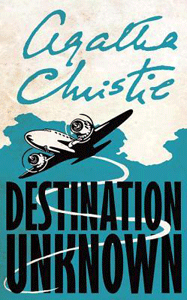“So Many Steps to Death” (1954, also published as “Destination Unknown”) is one of the most different Agatha Christie novels. It’s one of her sweeping spy novels (rather than a cozy murder mystery), but even in that context, it’s unusual. A relatively close comparison is her early globe-trotting adventure “The Man in the Brown Suit” (1924), but Anne is on the periphery of that scheme. Here, Hilary Craven is in the heart of it.
An unusual heroine
Hilary is both a blank slate and a fascinating individual. She is on the verge of committing suicide when a British government agent named Jessop recruits her to pose as a dead woman she bears a resemblance to, as part of a dangerous mission. Hilary figures “What the heck, at least I’ll go out with an adventure.” Psychologically, this woman and her scenario are unlikely, but for the sake of a novel, they are wild and entertaining.
Thematically, “So Many Steps to Death” calls to mind 21st century young-adult works such as the “Divergent,” “Hunger Games” and “Maze Runner” franchises. (Unlike those books, “So Many Steps to Death” has surprisingly never been adapted for the screen.) Believe me, I never thought I’d link those sagas with Christie. But it fits: The bad guys’ grand scheme is to totally control idealistic people for a bigger, sinister purpose.

“So Many Steps to Death” (1954)
Also published as: “Destination Unknown”
Author: Agatha Christie
Genre: Spy thriller
Settings: London, Northern Africa, eastern Europe, 1954
And Hilary, although not a teenager (she has been divorced once and lost a child), is young and naïve enough to fit as the protagonist. She senses wrongness the way a Tris or a Katniss does, but – like those teens – trails a little behind an adult reader’s broader perception of the forces manipulating her.
Where do those scientists go?
However, “So Many Steps to Death” is not set in a future dystopia; it’s set in 1954 – when the world is “bigger” and more mysterious than today, and when nuclear bomb and chemical warfare experiments are freshly terrifying.
Christie takes us behind the Iron Curtain and tries to imagine what life is like for scientists working for Communist states. Intriguingly, she doesn’t do this directly. She smoothly avoids naming actual countries. The situation Hilary and her new cohorts find themselves in is more of a metaphor and parallel to real-world situations.
Cleverly, Christie – although mostly opposed to the idea of citizens as subjects of the state — manages to be almost equally critical of corporatism. (She uses the word “capitalism,” but as the villain’s ultimate scheme involves unwilling as well as willing participants, corporatism – capitalism blended with coercion — is the clearer label.)

A grand scheme
As much as I like Hilary as a protagonist, Christie falls short of making her what we’d now call a “strong female lead” — a free-thinking heroine with agency. Even though most of “So Many Steps to Death” is from Hilary’s point of view, Christie weirdly tells the “happily ever after” portion from the male’s perspective.
The author falls back on the old-fashioned (even at the time of her writing) notion that a man’s feelings determine the fate of the relationship; the woman will be interested in the man because he’s attracted to her.
But that’s a minor, final-page quibble. The biggest element that keeps “So Many Steps to Death” from elite status is the B-plot of Jessop and company tracking Hilary’s group, which is taking planes, trains and automobiles all over northern Africa and eastern Europe.
Hilary leaves costume-jewelry pearls as breadcrumbs. This would be fair enough on a smaller scale, but when covering such a large geographic area, it’s ridiculous. Jessop has locals in various likely towns search for the pearls for a reward; it seems risky in the international spy game to advertise like that. (It’s also odd that we don’t get Hilary’s POV of leaving the pearls, and the wise action doesn’t quite jibe with her otherwise flustered state.)
Insight into Christie’s views
Basically, Christie makes the villain’s scheme for smuggling and hiding scientists (and their wives — or false wives, in the case of the undercover Hilary) so ingeniously thorough that it seems impossible Jessop could track the group. In order to stick with the novel, we have to shrug and say “Well, I guess he got lucky.”
Christie’s spy novels always take a while to grow on me, because I start off thinking “No Poirot? No Marple? No murder, even?!” This one is a particularly slow starter because Hilary is such an unlikely person to exist in reality.
But ultimately, “So Many Steps to Death” gives us more insight into Christie’s political concerns and viewpoints than just about any other novel, and that makes it fascinating.
Every week, Sleuthing Sunday reviews an Agatha Christie book or adaptation. Click here to visit our Agatha Christie Zone.

